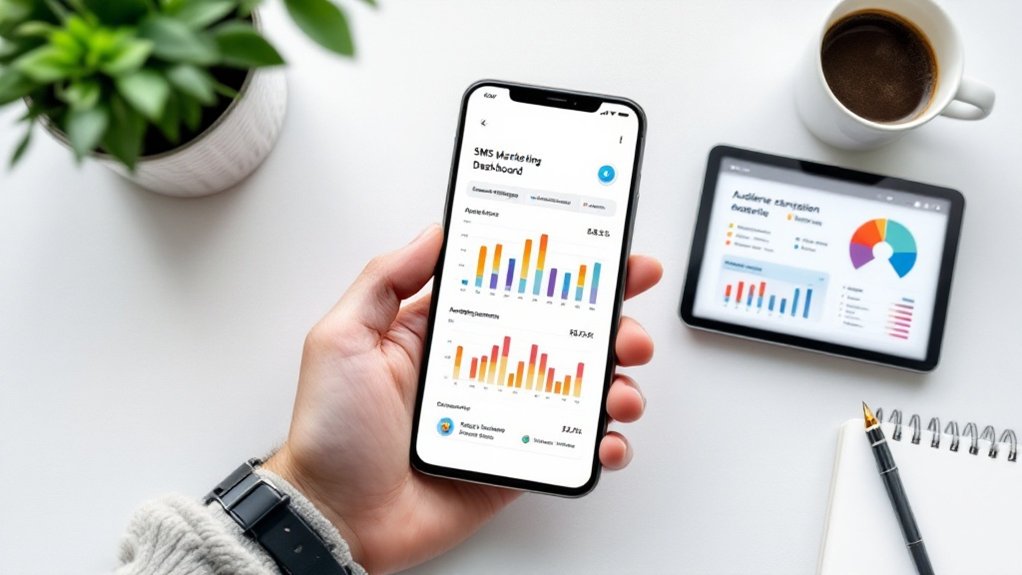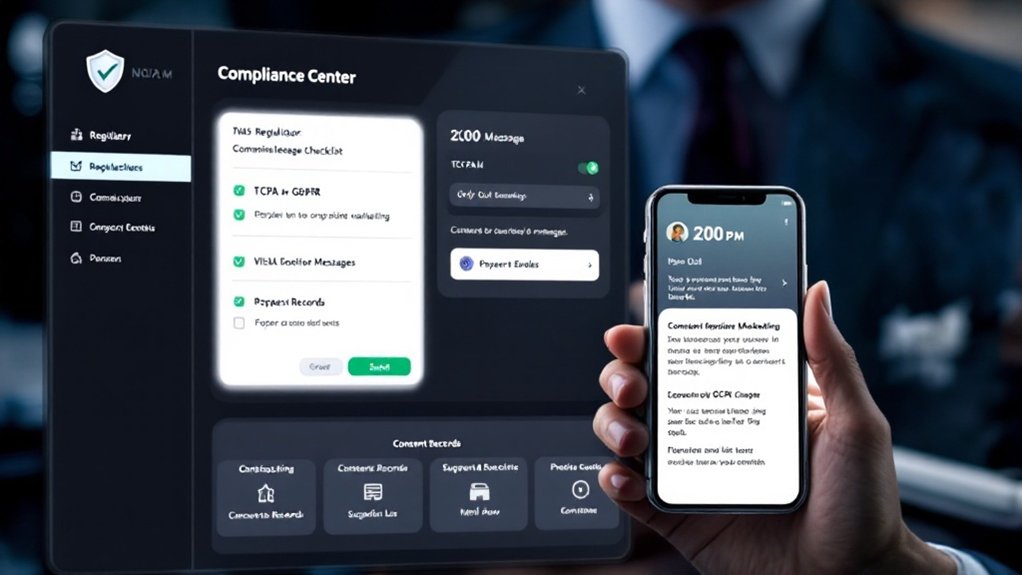SMS marketing software enables businesses to send targeted text messages to customer lists through cloud-based platforms. These tools provide essential features like bulk messaging, contact management, automation, and performance tracking. Companies can create personalized campaigns, schedule messages, and analyze engagement metrics while maintaining regulatory compliance. With two-way messaging capabilities and CRM integration, businesses can build stronger customer relationships. Understanding the key components helps maximize the potential of this powerful marketing channel.
Quick Overview
- SMS marketing software enables businesses to create, send, and track bulk text message campaigns to their customer base.
- Features include contact management, two-way messaging, automation tools, and detailed analytics for campaign performance tracking.
- Cloud-based platforms offer subscription pricing models with scalable solutions for businesses of all sizes.
- Compliance tools ensure adherence to regulations like TCPA and GDPR while maintaining proper consent and opt-out mechanisms.
- Integration capabilities allow seamless connection with CRM systems and other marketing channels for unified customer communication.
Understanding SMS Marketing Software Essentials

While text messaging has become a ubiquitous part of daily life, SMS marketing software transforms this simple communication tool into a powerful business asset. This specialized software enables companies to create, manage, and track text message campaigns that reach customers directly on their mobile devices.
At its core, SMS marketing software provides essential features that businesses need for effective mobile communication:
- Contact management tools for organizing customer lists
- Message creation with personalization options
- Automated scheduling capabilities
- Two-way messaging functionality
- Performance analytics
The software also guarantees compliance with important regulations like TCPA and GDPR, automatically handling opt-in processes and consent records.
Most solutions operate on cloud-based platforms with subscription pricing, making them accessible to businesses of all sizes. Integration capabilities with CRM systems and e-commerce platforms further enhance their utility in modern marketing strategies. Leading platforms like Omnisend deliver omnichannel marketing solutions that combine SMS, email, and push notifications for comprehensive customer engagement.
Key Features That Drive Campaign Success
Successful SMS marketing campaigns rely on a robust set of features that empower businesses to reach, engage, and convert their mobile audience effectively.
Modern SMS platforms offer essential tools like bulk messaging capabilities, allowing companies to send personalized texts to thousands of contacts simultaneously while maintaining a personal touch.
SMS solutions enable mass personalized messaging at scale, delivering individual attention to thousands of recipients through automated systems.
Advanced contact management features enable precise audience targeting through list segmentation and detailed subscriber information. Two-way conversation capabilities enhance customer engagement by enabling real-time interactions and immediate response handling.
Campaign automation tools streamline the process with drag-and-drop builders, ready-to-use templates, and AI-assisted content creation.
For data-driven decision making, thorough analytics track delivery rates, engagement metrics, and conversion statistics.
Security and compliance features guarantee messaging activities adhere to regulations like TCPA and GDPR, protecting both businesses and subscribers through encryption, secure storage, and proper opt-in management.
Implementing Effective SMS Marketing Strategies

Implementing an effective SMS marketing strategy requires careful planning and systematic execution across multiple key areas.
Successful campaigns start with building a strong opt-in subscriber list through website forms, point-of-sale collection, and social media promotion. Organizations must then focus on crafting compelling, concise messages that include clear calls-to-action and personalized content. Utilizing specialized SMS marketing software streamlines campaign management and delivery while providing essential analytics features.
Timing and frequency optimization play significant roles in campaign success. Companies should conduct A/B testing to determine ideal send times, segment their audience effectively, and respect subscriber preferences.
Throughout implementation, strict adherence to compliance regulations remains essential, including obtaining explicit consent and providing clear opt-out instructions.
Finally, integrating SMS marketing with other channels, such as email and social media, creates a cohesive customer experience that maximizes engagement and campaign effectiveness.
Measuring Performance and Analytics
Effectively measuring SMS marketing performance requires robust analytics and systematic tracking of key metrics. Successful campaigns rely on monitoring essential KPIs like delivery rates, open rates, and click-through rates to gauge message effectiveness.
Modern SMS marketing software provides extensive tools for tracking these metrics in real-time. Marketers can achieve sentiment-driven optimization by analyzing customer responses and categorizing them as positive, negative, or neutral.
Key performance indicators help marketers understand campaign success through:
Performance metrics serve as vital signposts, guiding marketers to measure and interpret the true impact of their campaign efforts.
- Conversion rates that show message effectiveness
- ROI calculations that demonstrate financial impact
- Response rates that indicate audience engagement
- Bounce rates that reveal delivery issues
Analytics tools enable data-driven optimization through features like A/B testing, segmentation analysis, and CRM integration.
Regulatory Compliance and Best Practices

While tracking metrics reveals campaign performance, regulatory compliance forms the foundation of any legitimate SMS marketing program. SMS marketers must adhere to key regulations like TCPA, CTIA guidelines, and the CAN-SPAM Act, while international businesses also need to take into account GDPR requirements. Messages containing SHAFT content like sex, hate, alcohol, firearms, or tobacco are strictly prohibited.
Essential compliance elements include obtaining express written consent, implementing clear opt-out mechanisms, and maintaining detailed consent records. Messages must identify the business name and avoid delivery during restricted hours (before 8 AM or after 9 PM local time).
Best practices involve regular program audits, staff training, and using compliance-focused platforms.
To maintain compliance, businesses should:
- Use double opt-in processes
- Include STOP options in every message
- Keep updated suppression lists
- Document all consent records
- Monitor state-specific regulations
Future Trends in SMS Marketing Technology
The future of SMS marketing technology stands at the threshold of revolutionary change. AI and machine learning are transforming how businesses interact with customers through SMS, enabling smarter chatbots, predictive analytics, and personalized content delivery.
SMS marketing is entering a new era where AI and machine learning enable unprecedented levels of customer engagement and personalization.
Key technological advancements are reshaping the landscape:
- Integration of RCS and 5G networks for enhanced messaging capabilities
- AI-powered content optimization and real-time personalization
- IoT connectivity for context-aware messaging
- Blockchain implementation for improved security
- Advanced analytics with predictive ROI forecasting
The convergence of these technologies is creating a more sophisticated SMS marketing ecosystem. With smartphone users projected to exceed seven billion by 2024, businesses must adapt their messaging strategies to reach this expanding mobile audience.
Businesses can now leverage automated workflows, cross-platform messaging, and unified customer data platforms to deliver highly targeted campaigns.
This evolution in SMS technology is enabling marketers to create more engaging, personalized, and measurable customer experiences across multiple channels.
Frequently Asked Questions
How Much Do Businesses Typically Spend per Month on SMS Marketing Software?
Businesses typically spend varying amounts on SMS marketing software based on their size and needs.
Small businesses with 1,000-5,000 contacts generally invest $20-$100 monthly, while medium-sized businesses managing 5,000-50,000 contacts spend $100-$500.
Large enterprises with over 50,000 contacts often pay $500-$2,000+ monthly.
These costs usually include features like automation, analytics, and integration capabilities.
Pay-as-you-go options are available starting at $0.01-$0.05 per message.
Can SMS Marketing Software Integrate With Point-Of-Sale (POS) Systems?
According to industry research, over 85% of modern POS systems now offer SMS integration capabilities.
Yes, SMS marketing software can readily integrate with POS systems through APIs and dedicated connectors. This integration enables businesses to automatically sync customer data, trigger purchase-based text campaigns, and track marketing performance.
Popular platforms like Square, Clover, and Oracle MICROS Simphony offer built-in SMS marketing features or seamless third-party integration options for enhanced customer engagement and sales tracking.
What Happens to Unopened SMS Messages After 24 Hours?
Unopened SMS messages follow a specific lifecycle after 24 hours. While the message remains on the recipient’s device if delivered, engagement rates drop considerably.
Carrier networks typically continue delivery attempts for up to 72 hours if the initial delivery failed. After this period, undelivered messages are permanently discarded.
For delivered messages, they stay in the recipient’s inbox until deleted, but marketing data shows they’re unlikely to be read after the first 24 hours.
Do Emojis in SMS Marketing Messages Affect Delivery Rates?
While some marketers worry that emojis might interfere with SMS delivery, research shows they don’t negatively impact delivery rates.
Modern networks fully support emoji transmission through Unicode encoding, maintaining delivery success rates of 95-98% regardless of emoji usage.
Messages transmit smoothly because carriers have adapted their infrastructure to handle these popular symbols.
However, emojis do slightly increase message size, though this rarely affects actual delivery performance or reliability.
How Often Should Businesses Clean Their SMS Subscriber Lists?
Businesses should clean their SMS subscriber lists at least monthly, with weekly metric reviews to catch potential issues early.
For best results, companies should:
- Conduct thorough list cleaning monthly
- Review engagement metrics weekly
- Run re-engagement campaigns quarterly
- Perform deep cleanings during high-volume seasons
More frequent cleaning may be necessary for businesses with large subscriber bases or high message volumes.
Regular maintenance helps improve delivery rates, reduce costs, and maintain strong engagement with customers.
Conclusion
SMS marketing software continues to evolve, adapt, and transform the way businesses connect with customers. By combining robust features, data-driven insights, and regulatory compliance, these platforms empower marketers to create meaningful mobile engagements. As technology advances, SMS marketing will integrate more AI capabilities, personalization tools, and cross-channel functionalities. The future of SMS marketing lies in smarter automation, deeper analytics, and more sophisticated customer journeys that drive measurable results.








